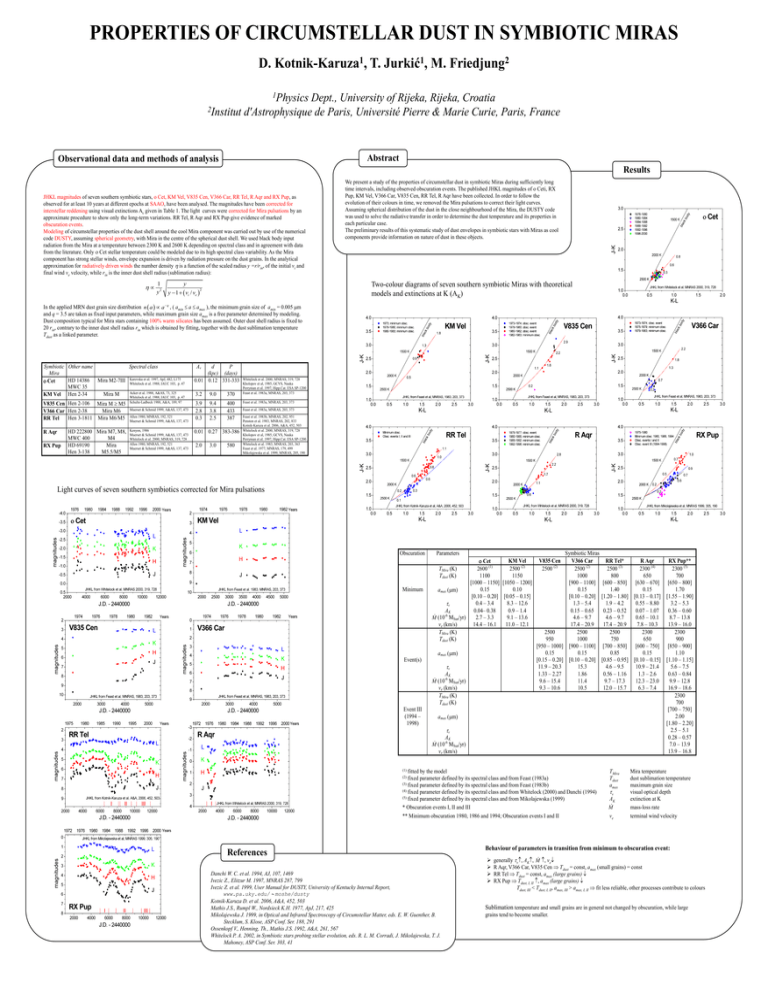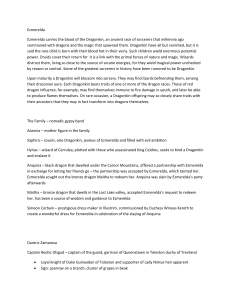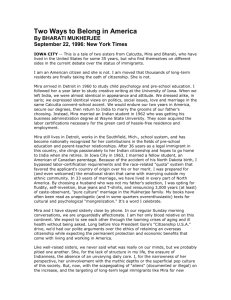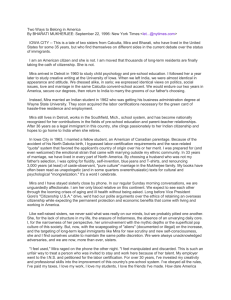PROPERTIES OF CIRCUMSTELLAR DUST IN SYMBIOTIC MIRAS
advertisement

PROPERTIES OF CIRCUMSTELLAR DUST IN SYMBIOTIC MIRAS D. 1 Kotnik-Karuza , T. 1 Jurkić , M. 2 Friedjung 1Physics Dept., University of Rijeka, Rijeka, Croatia 2Institut d'Astrophysique de Paris, Université Pierre & Marie Curie, Paris, France Abstract Observational data and methods of analysis Results JHKL magnitudes of seven southern symbiotic stars, o Cet, KM Vel, V835 Cen, V366 Car, RR Tel, R Aqr and RX Pup, as observed for at least 10 years at different epochs at SAAO, have been analysed. The magnitudes have been corrected for interstellar reddening using visual extinctions Av given in Table 1. The light curves were corrected for Mira pulsations by an approximate procedure to show only the long-term variations. RR Tel, R Aqr and RX Pup give evidence of marked obscuration events. Modeling of circumstellar properties of the dust shell around the cool Mira component was carried out by use of the numerical code DUSTY, assuming spherical geometry, with Mira in the centre of the spherical dust shell. We used black body input radiation from the Mira at a temperature between 2300 K and 2600 K depending on spectral class and in agreement with data from the literature. Only Cet stellar temperature could be modeled due to its high spectral class variability. As the Mira component has strong stellar winds, envelope expansion is driven by radiation pressure on the dust grains. In the analytical approximation for radiatively driven winds the number density h is a function of the scaled radius y =r/rin, of the initial vi and final wind ve velocity, while rin is the inner dust shell radius (sublimation radius): h 1 y2 Two-colour diagrams of seven southern symbiotic Miras with theoretical models and extinctions at K (AK) y y 1 vi / ve We present a study of the properties of circumstellar dust in symbiotic Miras during sufficiently long time intervals, including observed obscuration events. The published JHKL magnitudes of o Ceti, RX Pup, KM Vel, V366 Car, V835 Cen, RR Tel, R Aqr have been collected. In order to follow the evolution of their colours in time, we removed the Mira pulsations to correct their light curves. Assuming spherical distribution of the dust in the close neighbourhood of the Mira, the DUSTY code was used to solve the radiative transfer in order to determine the dust temperature and its properties in each particular case. The preliminary results of this systematic study of dust envelopes in symbiotic stars with Miras as cool components provide information on nature of dust in these objects. 2 In the applied MRN dust grain size distribution n a a q , ( amin a amax ), the minimum grain size of amin = 0.005 m and q = 3.5 are taken as fixed input parameters, while maximum grain size amax is a free parameter determined by modeling. Dust composition typical for Mira stars containing 100% warm silicates has been assumed. Outer dust shell radius is fixed to 20 rin, contrary to the inner dust shell radius rin which is obtained by fitting, together with the dust sublimation temperature Tdust as a linked parameter. Symbiotic Other name Spectral class Mira et al. 1997, ApJ, 482, L175 HD 14386 Mira M2-7III Karovska Cet Whitelock et al. 1988, IAUC 103, p. 47 MWC 35 Acker et al. 1988, A&AS, 73, 325 Mira M KM Vel Hen 2-34 Whitelock et al. 1988, IAUC 103, p. 47 d P (kpc) (days) 0.01 0.12 331-333 3.2 9.0 370 V835 Cen Hen 2-106 Mira M M5 Mira M6 V366 Car Hen 2-38 Hen 3-1811 Mira M6/M5 RR Tel 3.9 2.8 0.3 9.4 3.8 2.5 400 433 387 R Aqr RX Pup HD 222800 Mira M7, M8, MWC 400 M4 HD 69190 Mira Hen 3-138 M5.5/M5 Schulte-Ladbeck 1988, A&A, 189, 97 Muerset & Schmid 1999, A&AS, 137, 473 Allen 1980, MNRAS, 192, 521 Muerset & Schmid 1999, A&AS, 137, 473 Kenyon, 1986 Muerset & Schmid 1999, A&AS, 137, 473 Whitelock et al. 2000, MNRAS, 319, 728 Allen 1980, MNRAS, 192, 521 Muerset & Schmid 1999, A&AS, 137, 473 Av 0.01 0.27 383-386 2.0 3.0 580 Whitelock et al. 2000, MNRAS, 319, 728 Kholopov et al, 1985, GCVS, Nauka Perryman et al. 1997, Hipp.Cat. ESA SP-1200 Feast et al. 1983a, MNRAS, 203, 373 Feast et al. 1983a, MNRAS, 203, 373 Feast et al. 1983a, MNRAS, 203, 373 Feast et al. 1983b, MNRAS, 202, 951 Penston et al. 1983, MNRAS, 202, 833 Kotnik-Karuza et al. 2006, A&A, 452, 503 Whitelock et al. 2000, MNRAS, 319, 728 Kholopov et al, 1985, GCVS, Nauka Perryman et al. 1997, Hipp.Cat. ESA SP-1200 Whitelock et al. 1983, MNRAS, 203, 363 Feast et al. 1977, MNRAS, 179, 499 Mikolajewska et al. 1999, MNRAS, 205, 190 Light curves of seven southern symbiotics corrected for Mira pulsations Obscuration Minimum Parameters KM Vel Cet TMira (K) 2600 (1) 2500 (2) Tdust (K) 1100 1150 [1000 – 1150] [1050 – 1200] 0.15 0.10 amax (m) [0.10 – 0.20] [0.05 – 0.15] 0.4 – 3.4 8.3 – 12.6 v AK 0.04– 0.38 0.9 – 1.4 2.7 – 3.3 9.1 – 13.6 M (10-6 MSun/yr) ve (km/s) 14.4 – 16.1 11.0 – 12.1 TMira (K) Tdust (K) amax (m) Event(s) Event III (1994 – 1998) v AK -6 M (10 MSun/yr) ve (km/s) TMira (K) Tdust (K) V835 Cen 2500 (2) 2500 950 [950 – 1000] 0.15 [0.15 – 0.20] 11.9 – 20.3 1.33 – 2.27 9.6 – 15.4 9.3 – 10.6 Symbiotic Miras V366 Car 2500 (2) 1000 [900 – 1100] 0.15 [0.10 – 0.20] 1.3 – 5.4 0.15 – 0.65 4.6 – 9.7 17.4 – 20.9 2500 1000 [900 – 1100] 0.15 [0.10 – 0.20] 15.3 1.86 11.4 10.5 RR Tel* 2500 (3) 800 [600 – 850] 1.40 [1.20 – 1.80] 1.9 – 4.2 0.23 – 0.52 4.6 – 9.7 17.4 – 20.9 2500 750 [700 – 850] 0.85 [0.85 – 0.95] 4.6 – 9.5 0.56 – 1.16 9.7 – 17.3 12.0 – 15.7 amax (m) v AK -6 M (10 MSun/yr) ve (km/s) (1) RX Pup** 2300 (5) 700 [650 – 800] 1.70 [1.55 – 1.90] 3.2 – 5.3 0.36 – 0.60 8.7 – 13.8 13.9 – 16.0 2300 900 [850 – 900] 1.10 [1.10 – 1.15] 5.6 – 7.5 0.63 – 0.84 9.9 – 12.8 16.9 – 18.6 2300 700 [700 – 750] 2.00 [1.80 – 2.20] 2.5 – 5.1 0.28 – 0.57 7.0 – 13.9 13.9 – 16.8 fitted by the model (2) fixed parameter defined by its spectral class and from Feast (1983a) (3) fixed parameter defined by its spectral class and from Feast (1983b) (4) fixed parameter defined by its spectral class and from Whitelock (2000) and Danchi (1994) (5) fixed parameter defined by its spectral class and from Mikolajewska (1999) * Obscuration events I, II and III AK M Mira temperature dust sublimation temperature maximum grain size visual optical depth extinction at K mass-loss rate ** Minimum obscuration 1980, 1986 and 1994; Obscuration events I and II ve terminal wind velocity References Danchi W. C. et al. 1994, AJ, 107, 1469 Ivezic Z., Elitzur M. 1997, MNRAS 287, 799 Ivezic Z. et al. 1999, User Manual for DUSTY, University of Kentucky Internal Report, www.pa.uky.edu/ ~ moshe/dusty Kotnik-Karuza D. et al. 2006, A&A, 452, 503 Mathis J.S., Rumpl W., Nordsieck K.H. 1977, ApJ, 217, 425 Mikolajewska J. 1999, in Optical and Infrared Spectroscopy of Circumstellar Matter, eds. E. W. Guenther, B. Stecklum, S. Klose, ASP Conf. Ser. 188, 291 Ossenkopf V., Henning, Th., Mathis J.S. 1992, A&A, 261, 567 Whitelock P. A. 2002, in Symbiotic stars probing stellar evolution, eds. R. L. M. Corradi, J. Mikolajewska, T. J. Mahoney, ASP Conf. Ser. 303, 41 TMira Tdust amax R Aqr 2300 (4) 650 [630 – 670] 0.15 [0.13 – 0.17] 0.55 – 8.80 0.07 – 1.07 0.65 – 10.1 7.8 – 10.3 2300 650 [600 – 750] 0.15 [0.10 – 0.15] 10.9 – 21.4 1.3 – 2.6 12.3 – 23.0 6.3 – 7.4 v Behaviour of parameters in transition from minimum to obscuration event: generally v, AK, M , ve R Aqr, V366 Car, V835 Cen Tdust = const, amax (small grains) = const RR Tel Tdust = const, amax (large grains) RX Pup Tdust, I, II , amax (large grains) Tdust, III < Tdust, I, II, amax, III > amax, I, II fit less reliable, other processes contribute to colours Sublimation temperature and small grains are in general not changed by obscuration, while large grains tend to become smaller.





